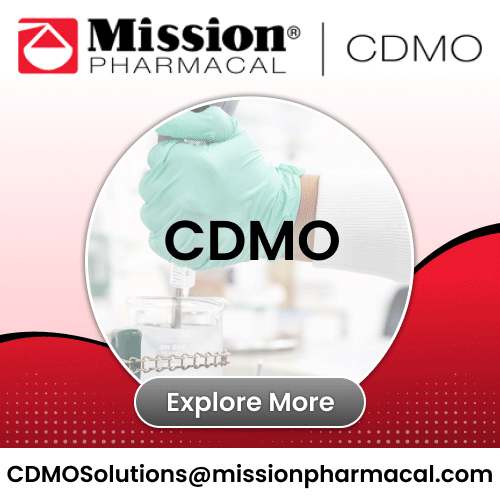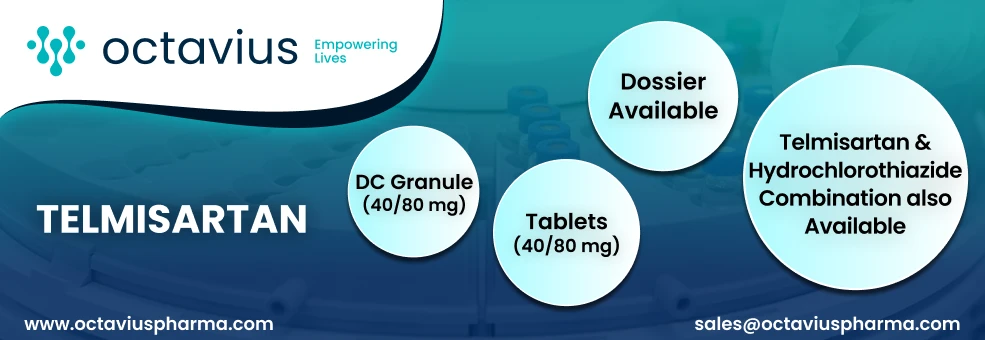What is Telmisartan?
Telmisartan is an angiotensin II receptor antagonist (ARB) used
in the management of hypertension. Generally, angiotensin II receptor blockers (ARBs) such as telmisartan bind to the angiotensin II type 1 (AT1) receptors with high affinity, causing inhibition of the action of angiotensin II on vascular smooth muscle, ultimately leading to a reduction in arterial blood pressure. Recent studies suggest that telmisartan may also have PPAR-gamma agonistic properties that could potentially confer beneficial metabolic effects.
What is Telmisartan mechanism of action?
Telmisartan interferes with the binding of angiotensin II to the angiotensin II AT1-receptor by binding reversibly and selectively to the receptors in vascular smooth muscle and the adrenal gland. As angiotensin II is a vasoconstrictor, which also stimulates the synthesis and release of aldosterone, blockage of its effects results in decreases in systemic vascular resistance. Telmisartan does not inhibit the angiotensin converting enzyme, other hormone receptors, or ion channels. Studies also suggest that telmisartan is a partial agonist of PPAR?, which is an established target for antidiabetic drugs. This suggests that telmisartan can improve carbohydrate and lipid metabolism, as well as control insulin resistance without causing the side effects that are associated with full PPAR? activators.
Find Telmisartan Impurity related updates on PharmaCompass. Follow all updates on the Telmisartan NDMA impurity problem through PharmaCompass so that you get all the updated information on time from trusted sources.
N-Nitrosodimethylamine (NDMA) impurity of Telmisartan, also known as dimethylnitrosamine, is a semi-volatile organic chemical (sartan impurity), produced as by-product of several industrial processes and present at very low levels in certain foodstuffs, especially those cooked, smoked, or cured. NDMA is water-soluble, yellow in color, and it has little or no taste and odor. N-Nitrosodimethylamine is toxic to the liver and other organs, and is a probable human carcinogen. It is also used to create cancer in rats for cancer research.
Telmisartan impurity Analytical Testing (NDMA) is found in water and some foods at trace levels, and is potentially carcinogenic. The next step for regulators was to find the companies affected by contaminated API and suggest product recalls.
While the cause of the impurity is not yet clear, it’s a belief that combination of conditions, which include certain chemicals, processing conditions and production steps, could lead to formation of the NDMA impurity Testing in Telmisartan. The risks are introduced through a specific sequence of steps in the manufacturing process of Telmisartan, where certain chemical reactions are needed to form the active ingredient."
What are the bioanalytical methods used in the development and validation of Telmisartan?
Basically, Bioanalytical Method Validation (BMV) means the methods used to check and prove the validity or accuracy of chemical substances like Telmisartan API. Global Bioanalytical Method Validation guidelines for Telmisartan are applied to bioanalytical methods that are used for the quantitative determination of Telmisartan generic forms or their metabolites to ensure that Telmisartan generic consumed as therapeutic products are free from Telmisartan impurities or Telmisartan related impurities. Telmisartan Bioanalytical Method Validation guidelines are also applicable for the bioanalytical method validation of small molecules. Various process used in detecting Telmisartan impurities are Telmisartan analytical methods, NDMA Analytical Testing.
Telmisartan Impurity NDMA (N-Nitrosodimethylamine), a contaminant in water and meat samples, has recently been identified as a contaminant in Telmisartan API. NDMA Validation or NDMA impurity validation in Telmisartan. Its presence has to be regulated or tested as it is a probable human carcinogen which means the presence of NMDA in medicines poses risks of getting cancer. Various types of Telmisartan impurities are Telmisartan Related Compound A, Telmisartan Related Compound B, Telmisartan Related Compound C and Telmisartan Methyl Ester,Telmisartan USP Impurity A, Telmisartan USP Impurity B, Telmisartan USP Impurity C, Telmisartan Ethyl Ester etc.
N-Nitrosodimethylamine impurity (Telmisartan Impurity NDMA) is a known environmental contaminant. For context, it is found in water and foods including meats, dairy products and vegetables. The removal of N-Nitrosodimethylamine (NDMA Testing or NDMA Analytical Impurity Testing) from water is extremely important step before it is used in the production of Telmisartan API. Global pharmaceutical companies are now designing specific Telmisartan Bioanalytical methods for NDMA Testing or Telmisartan Impurity testing or NDMA method development for generic medicines. Apart from ensuring GMP compliance and top-notch quality, pharmaceutical companies need to test high throughput active pharmaceutical ingredient samples for the presence of Telmisartan NMDA or N-nitrosodiethylamine impurity (NDEA).
Contract research organizations (CROs) for Telmisartan NDMA Impurity Testing or Telmisartan NDMA Testing Method. Several NDMA bioanalytical methods are available for Validation of NDMA Impurity in Telmisartan. NDMA impurity testing in Telmisartan is using bioanalytical techniques like HPLC, LC-MS, GC-MS are an effective tool in accessing impurity. CROs for Telmisartan NDMA impurity testing are GLP/GMP certified labs which detect the contamination or impurity in drugs. The FDA has presented validated method for Telmisartan generic forms are free of Telmisartan impurities. It is the gas chromatography-mass spectrometry (GC/MS) headspace method for manufacturers and regulators to utilize fully for detecting NMDA impurity. According to the latest method presented by FDA, out of other Bioanalytical Method Validation of Telmisartan processes, specifically the GC/MS Headspace Method was selected for Detection of NDMA. The Telmisartan Impurity N-nitrosodimethylamine (NMDA) investigation document states that Telmisartan Impurity NMDA is an impurity which is classified as a probable human carcinogen and is believed to have been introduced into the finished products as a result of the manufacturing process of the drug substance. Telmisartan validation service providers. The limit of Quantitation used in Telmisartan impurity validated methods for detection of NMDA Telmisartan impurity is 0.3 ppm. Hence, if the Telmisartan drug substance samples exceed this value or contain Telmisartan impurities, it presents a significant challenge in its utilization.
Bioanalytical validation methods of Telmisartan Impurity play a significant role in evaluation and interpretation of bioavailability, bioequivalence, pharmacokinetic, and toxicokinetic studies. In which different parameters like accuracy, precision, selectivity, sensitivity, reproducibility, and stability are performed. Telmisartan analytical methods, Telmisartan Bioanalytical Method Development & Validation Service providers CROs / CDMOs have vast experience in Validated methods for Active Pharmaceutical Ingredients (APIs) for a variety of platforms including HPLC (High Performance Liquid Chromatography), RP-HPLC (Reverse Phase- High Performance Liquid Chromatography), RP-UPLC (Reverse Phase- Ultra Performance Liquid Chromatography), LC/MS/MS, GC/MS or GC/FID, ICP/MS, and ligand binding assays (ELISA or other cell-based assays). As both an in vivo and analytical CRO, they support bioanalytical method development & validation of Telmisartan services of a variety of Active Pharmaceutical Ingredients (APIs) / Drugs. Bioanalytical methods and validation studies for Telmisartan are typically conducted under GLPs, where product release and stability tests follow GMP quality requirements.
NDMA method Development and validation or NDMA Validation is the process used to confirm that the analytical procedure employed for a specific test is suitable for its intended use. NDMA method Development and validation Results from method validation can be used to judge the quality, reliability and consistency of analytical results; Telmisartan NDMA Testing Method is an integral part of any good analytical practice. It is the process of defining an analytical requirement, NDMA Analytical and confirms that the method under consideration has performance capabilities of NDMA Characterization consistent with what the application requires. NDMA bioanalytical method Development and validation is within specification, working correctly and adequately calibrated is fundamental to the method validation process. NDMA Bioanalytical method development carrying out the studies by using NDMA Suppliers perform NDMA Testing Service Providers must be competent in the analysis and NDMA Characterization under study and have sufficient knowledge of the method/analysis to draw conclusions from the observations as the validation work proceeds by using NDMA Testing Service Providers. NDMA Bioanalytical method development is Quite often method validation evolves from method development and so the two activities are often closely tied, with the validation study employing the techniques and steps in the analysis NDMA Method development service providers as defined by the method development. Other NDMA Impurity assessments are Telmisartan NDMA Impurity Testing, Telmisartan NDMA Testing Method and Validation of NDMA Impurity in Telmisartan. Analytical methods need to be validated or revalidated. NDMA Validation Development and NDMA Analytical In many cases, methods are developed and validated in service laboratories that are specialized in this task. NDMA validated methods or validated methods for NDMA is critical tool for accessing Telmisartan. NDMA Process Development is the method is transferred to the routine analytical laboratory, care should be taken that the method and its critical parameters are well understood by the workers in the departments who apply the method NDMA Isolation and Identification. NDMA Process Development or A detailed validation protocol and NDMA Validation technique a documented procedure for method implementation and good communication between the development and operation departments are equally important. Telmisartan method development and validation is an essential tool to process Telmisartan NDMA Impurity Testing in a drug substance. ICH provides a guideline for NDMA testing or NDMA Analytical testing. NDMA Analysis or NDMA Telmisartan Analysis is to be done in GMP/GLP certified laboratory where company has to perform NDMA testing by using NDMA analytical testing methods in Telmisartan by using NDMA bioanalytical methods. NDMA Bioanalytical method development is performed by using HPLC/LC-MS methods. NDMA contamination in Telmisartan is carcinogenic which has been found in studies done on Rat/Mice. NDMA Validation Method, NDMA Isolation and Identification If the method is used by a number of departments, it is recommended to verify method validation parameters and to test the applicability and usability of the method in a couple of these departments before it is distributed to other departments. NDMA Impurity testing can be done by Telmisartan NDMA Impurity Testing, Telmisartan NDMA Testing Method and Validation of NDMA Impurity in Telmisartan, NDMA Isolation Technique, NDMA Validation technique In this way, problems can be identified and corrected before the method NDMA Identification is distributed to a larger audience. NDMA Isolation and Identification If the NDMA Analytical method is intended to be used by just one or two departments, an analyst from the development department should assist the users of the method during initial operation. NDMA Validation Development method should be encouraged to give constant feedback on the applicability and usability of the method to the development department. The latter should correct problems if any arise.
Validated routine methods NDMA Assay are transferred between laboratories at the same or different sites when contract laboratories offer services like NDMA Assay, NDMA Analytical Testing Assay for routine analysis in different areas or when products are manufactured in different areas. NDMA Testing Assay When validated routine methods are transferred between laboratories and sites, their validated state should be maintained to ensure the same reliable results in the receiving laboratory. NDMA impurity testing and NDMA Analytical Testing means the competence of the receiving laboratory to use the method should be demonstrated through tests, for example, repeat critical method validation experiments and run samples in parallel in the transferring and receiving laboratories. Other NDMA Impurity assessments are Telmisartan NDMA Impurity Testing, Telmisartan NDMA Testing Method and Validation of NDMA Impurity in Telmisartan.
Limit of Quantification (LOQ) Lower limit of quantification
For Telmisartan, the Development and Validation of RP-HPLC method for NDMA quantification and NDMA Purification including its NDMA validation technique for Pharmaceutical Formulations is of utmost importance. Research by KS Rao, N Jena, and MEB Rao (J Young Pharm. reported a stress Telmisartan NDMA testing method of Telmisartan carried out under acidic, alkaline, oxidative, thermal, and photolytic conditions. The authors presented a stability-indicating HPLC assay method used in the development and validation methods of Telmisartan in bulk drug and pharmaceutical dosage forms and to remove Telmisartan impurities. The Telmisartan NDMA testing method was based on an isocratic RP-HPLC on Waters 2695 using Symmetry C18 (250mm × 4.6mm × 5?) column with the mobile phase consisting of 0.02 mM sodium dihydrogen ortho-phosphate, with the pH adjusted to 2.5 using ortho-phosphoric acid (solvent A), and acetonitrile (solvent B) in the ratio of 58:42 %v/v. NDMA validation for Telmisartan analytical methods. NDMA validation or NDMA purification is proposed isocratic RP-HPLC method for Bioanalytical testing of Telmisartan and Telmisartan impurity testing was validated as per ICH guidelines and the authors found it to be suitable for the quality control of Telmisartan in bulk and pharmaceutical dosage forms as well as the stability-indicating studies.
As both an in vivo and analytical CRO, they support bioanalytical method development & validated methods of Telmisartan. Bioanalytical studies for Telmisartan are typically conducted under GLPs, where product release and stability tests follow GMP quality requirements. NDMA Validated Methods which the requirements for Telmisartan purification processes can be discussed on a per-project basis so that the supplied Telmisartan API conforms to international standards and is ensured of free from Telmisartan impurities. Removal of NDMA and NMDA is one of the core processes involved in bioanalytical chromatographic methods of Telmisartan API production.
Bioanalytical testing techniques used in Validation of Telmisartan: Commonly used Bioanalytical chromatographic methods in validation testing for Telmisartan are as follows: Hyphenated techniques: A hyphenated technique is combination or coupling of two different analytical techniques with the help of proper interface. NDMA Validated Methods and Mainly chromatographic techniques are combined with spectroscopic techniques to ensure a validated method for Telmisartan purification is used, for e.g. LC–MS (liquid chromatography–mass spectrometry); GC–MS (gas chromatography–mass spectrometry); CE–MS (capillary electrophoresis–mass spectrometry) Liquid Chromatography-Mass Spectrometry (LC-MS/MS or LC-MS-MS): Bioanalytical liquid chromatography-mass spectrometry or Bioanalytical Mass
Spectrometry is a technique that uses liquid chromatography with the mass spectrometry. LC-MS or LC-MS-MS and rapid and sensitive high performance LC/MS/MS for Telmisartan is commonly used validated method for Telmisartan impurity testing in laboratories for the quantitative and qualitative estimation of Telmisartan impurity, conduct additional analysis to check Telmisartan bioavailability and check the presence of Telmisartan related impurities. Telmisartan analytical testing methods. LC-MS has played an important role in evaluation and interpretation of bioavailability, bioequivalence and pharmacokinetic details of Telmisartan. NDMA Validated Methods which is also used in the quantitative analysis of Telmisartan impurities and in validation methods for Telmisartan.
The gas chromatography-mass spectrometry (GC/MS) method provided by FDA is being used in pharmaceutical companies and API manufacturing firms using the latest validated methods for ensuring the quality and accuracy of Telmisartan APIs. NDMA Analytical Method,Through LC-MS biological samples are determined throughout all phases of method development of NDMA and its salts in research and quality control. NDMA Levels in Telmisartan and HPLC (high performance liquid chromatography) & Gas chromatography are also important for the analysis of Telmisartan drug substances.
Chromatographic separations and Telmisartan impurity testing using RP-HPLC and RP-UPLC methods are considered as rapid stability indicating methods which depend on the samples to be analyzed. The chromatographic procedure used during bioanalytical testing method for Telmisartan is important for the systemic approach to LC-MS/MS method development.
GAS CHROMATOGRAPHY-MASS SPECTROMETRY (GC-MS) is a method that combines the features of gas-liquid chromatography and mass spectrometry to identify different Telmisartan salts within a test sample. Applications of GC-MS include drug detection, fire investigation, environmental analysis, NDMA Analytical Method, Telmisartan cancer risk testing, and Method Validation of Telmisartan, Telmisartan impurity testing and also developing the same for other drug products. NDMA Analytical Testing or NDMA testing, The fundamental bioanalytical method validation parameters include precision and accuracy, sensitivity. Another innovative bioanalytical method validation technique is solid phase extraction bioanalysis or SPE bioanalysis. Validation of NDMA Impurity in Telmisartan. Telmisartan analytical testing methods. NDMA Analytical Method or NDMA testing ,There are many optimization and validation studies on Telmisartan have been carried out for the assessment of SPE for Telmisartan, including those for Telmisartan impurity testing and characterization. Telmisartan impurity validation service providers. NDMA Analytical Method, A sensitive, specific bioanalytical method provided by Bioanalytical Service Providers is critical for a reliable pharmacokinetic experiment. A Bioanalytical Service Provider must ensure that all Telmisartan impurities have been removed and the API is up to the standards for therapeutic use.
Telmisartan Impurity Testing involves Comparative assessment of bioanalytical method validation several different techniques such as Method Transfer of Telmisartan, Partial Validation of Telmisartan, and Cross Validation of bioanalytical methods for Telmisartan and other Chromatographic techniques, especially, high performance liquid chromatography (HPLC) for Telmisartan assay coupled with different detection systems like LC-MS/MS bioanalysis method development, Telmisartan analytical impurity testing methods, validation, and sample analysis and RP-HPLC and RP-UPLC techniques are some of the preferred techniques, routinely employed in bioanalytical laboratories as compared to any other method of analysis owing to their precision, accuracy, reliability and applicability to large-scale analysis. Telmisartan Impurity Testing Companies. Telmisartan Validation, the goal of Telmisartan Impurity Testing is to determine whether the obtained data for Telmisartan impurity testing across different Telmisartan API samples are comparable. NDMA Validated Methods and Telmisartan analytical impurity testing methods.ND Cross validation assay is another Telmisartan impurity testing process and also include method transfer techniques consists of analysis of quality control samples (either spiked, incurred samples, or both), assayed under the different experimental conditions or different sites with validated methods of Telmisartan testing, as appropriate for ensuring minimal or absence of Telmisartan cancer risk.
What are the Essential Attributes of Bioanalytical Methods used in the Development and Validation of Telmisartan API?
Limit of detection (LOD) and limit of quantification (LOQ) are two important performance characteristics in bioanalytical method validation. Limit of Quantification (LOQ) - the detection limit, lower limit of detection, or LOD, is the lowest quantity of a substance that can be distinguished from the absence of that substance according to a standard confidence level. Telmisartan Impurity Testingand NDMA testing Services. Method validation service providers.The estimation of baseline noise can be quite difficult for bioanalytical validation methods, if matrix peaks elute close to the analyte peak.
Upper limit of quantification (ULOQ)
The upper limit of quantification (ULOQ) is the maximum analyte concentration of a sample that can be quantified with acceptable precision and accuracy (bias). Bioanalytical method companies.In general, the ULOQ value of Telmisartan is identical with the concentration of the highest calibration standard and becomes an important reference point for Telmisartan validation process.
The same set of samples for Telmisartan API should be measured by both analytical sites or using the two different Bioanalytical methods. NDMA Analytical Testing and NDMA method Development and validation, As notified by the FDA, cross validation should be performed in advance of study samples being analyzed in Telmisartan samples so that Telmisartan impurities are removed in the primary steps of manufacturing in small throughput and large throughput samples. NDMA Analytical Testing, It is recommended that the following rationale should be used in deciding how best to perform the cross validation method for Telmisartan or NDMA Validated Methods.
Telmisartan NDMA impurity can be detected using both gas and liquid chromatography. Global pharmaceutical companies perform a wide variety of NDMA impurity testing methods and validated methods for Telmisartan on numerous Telmisartan products to take care of all Telmisartan impurity testing challenges and comply with international Bioanalytical NDMA method validation guidelines of Telmisartan, NDMA testing or NDMA Validated Methods a validated method for valsatan analysis is Quality By Design(QbD) development of bioanalytical method is a novel method for the analysis of drug products extensively used in the industries for removal of Telmisartan impurities.
High performance liquid chromatography (HPLC) is one of the most accurate methods widely used for the quantitative & qualitative analysis of Telmisartan to remove Telmisartan impurities. Telmisartan impurity testing and is used for determining Telmisartan stability. Stability indicating HPLC methods are used to separate various drug related impurities that are formed during the synthesis or manufacture of Telmisartan. NDMA Analytical testing During bulk drug manufacturing of Telmisartan, tackling the presence of Telmisartan impurities can be challenging as the Telmisartan intermediates have complex chemical structures whose effects may not be known. NDMA Validated Methods and Method validation service providers. Various research laboratories are pursuing in-depth characterizations on Telmisartan impurities NDMA and NMDA and NDEA to understand the Telmisartan impurities structure, Telmisartan impurities physical and chemical properties and the cytotoxic effects of Telmisartan impurities on clinical samples. Other research groups are conducting studies on refining Telmisartan impurity testing methods.
 Boost your online visibility by uploading your products, APIs, FDFs, intermediates, excipients, and services for free on PharmaCompass.
Rank higher among suppliers and expand your reach across the internet efficiently and cost-effectively.
Boost your online visibility by uploading your products, APIs, FDFs, intermediates, excipients, and services for free on PharmaCompass.
Rank higher among suppliers and expand your reach across the internet efficiently and cost-effectively.

















